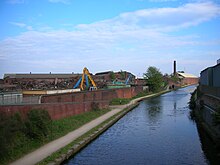Soho Foundry
The Soho Foundry was a machine factory in Handsworth (now part of Birmingham ) that had been built by entrepreneurs Matthew Boulton and James Watt to produce steam engines .
The factory was founded in 1795 after Boulton and Watt had been marketing Watt's steam engine in a partnership since 1775 and the production of individual parts by suppliers, which had been customary up until then, was no longer sufficient. Since Boulton's main production site, the Soho Manufactory, was not equipped for the heavy work and building new machine shops on the site was no longer an option, a new, nearby production site was sought. The site in Handsworth, which was ultimately selected, was located on a newly built canal and thus enabled easy delivery of even the heaviest machines. For this purpose, a new branch channel was led onto the company premises, which is now filled in; only the bridge that led over the branch canal on the canal bank still exists and, like the still existing main gate and the adjacent factory road with historic residential buildings for company employees, is a listed building. The necessary buildings were built quickly after the land was purchased, so that the factory was officially opened on January 30, 1796.
After both the patent protection of Watt's machine construction and the partnership agreement of the company founders expired in 1800, they handed the company over to their sons, Matthew Robinson Boulton and James Watt Jr. During their time, the decision was made to abandon the monopoly granted by the British Parliament for the construction of gas stations and street lighting, which the Scottish engineer William Murdoch , who had worked for the company since 1777, had developed, as no profits were expected from this business. As it turned out after the monopoly came to an end, this was a blatant misjudgment. Since neither Murdoch nor the company had secured the patent on the invention, they could not participate in the global business.
After the death of the sons of the company founder, the company in 1848 passed into the ownership of HW Blake, the company name to James Watt & Co changed. The spectacular construction of the sailing steamer Great Eastern , for which the factory supplied the propellers, fell under his auspices .
The prosperous company was sold to Avery Berkel in 1895 , which soon after became a public company. Today, weights for precision scales are manufactured on parts of the company premises. Some historic buildings, including Murdoch's house from 1817, are listed; Another area of the former factory site is used as a scrapyard.
Trivia
Since the company site is on the former border between the small town of Handsworth and the larger Smethwick , the factory is often referred to as belonging to Smethwick. Officially, however, it was part of the community of Handsworth, on whose grounds the access road, today's Foundry Lane , is located.
literature
- Jenny Uglow : The Lunar Men . 2nd Edition. Faber And Faber Ltd, London 2003, ISBN 0-571-21610-2 .
- WKV Gale: Soho Foundry . W&T Avery Ltd., Birmingham, England 1946, p. 49.
- WKV Gale, WA Seaby: Boulton, Watt and the Soho Undertakings . City of Birmingham Museum and Art Gallery, Birmingham, England 1966, p. 40.
- George Demidowicz: The First Specialized Engine Building Works . In: Warwickshire Industrial Archeology Society (Ed.): Warwickshire Industrial Archeology Society Newsletter . No. 23, Warwickshire, England, 2006, p. 3. Retrieved 11-12-2008.
Web links
Coordinates: 52 ° 29 ′ 49.9 ″ N , 1 ° 56 ′ 51 ″ W.

